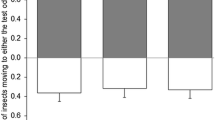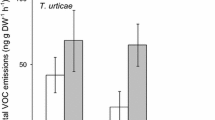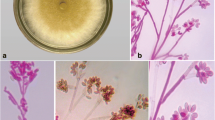Abstract
Volatile compounds exuded from axenically grown free-living nematodes were determined with gas chromatographic and mass spectrometric techniques. Carbon dioxide evolved from 5–200 nematodes was determined with an ampoule technique, whereas total ammonia (NH3 + NH4 +) and acetic and propionic acids were determined by direct injection of water in which nematodes had been suspended for 1–3 days. CO2 amounted to about 80 ng nematode−1 d−1, total ammonia to 1–5 ng, and acetic and propionic acids to 0.5 and 1.0 pg nematode−1 d−1.
The effects of these compounds on induction of trap formation in the nematodetrapping fungusArthrobotrys oligospora were tested. CO2 inhibited trap formation at 5–10% CO2 in air (v/v), whereas ammonia stimulated trap formation in a certain concentration range. No effects of acetic and propionic acids were noted for the concentrations tested. The combined effects of these volatiles in the aqueous environment are discussed on the basis of stoichiometric considerations.
Similar content being viewed by others
References
Bartnicki-Garcia, S., J. Eren, and D. Pramer: Carbon-dioxide-dependent morphogenesis inArthrobotrys conoides. Nature204, 804 (1964)
Brown, M. E.: Rhizosphere microorganisms—opportunists, bandits or benefactors. In N. Walker (ed.): Soil Microbiology. A Critical Review. Butterworths, London and Boston (1975)
Fries, N.: Effects of volatile organic compounds on the growth and development of fungi. Trans. Br. Mycol. Soc.60, 1–21 (1973)
Gilbert, R. G., and G. E. Griebel: The influence of volatile substances from alfalfa onVerticillium dahliae in soil. Phytopathology59, 1400–1403 (1969)
Hammen, C. S.: Respiratory quotient ofPanagrellus redivivus. Nematologica13, 599–604 (1967)
Henis, Y., and I. Chet: Mode of action of ammonia onSclerotium rolfsii. Phytopathology57, 425–427 (1967)
Ioannou, N., R. W. Schneider, and R. G. Grogan: Effect of oxygen, carbon dioxide, and ethylene on growth, sporulation and production of microsclerotia byVerticillium dahliae. Phytopathology67, 645–650 (1977)
Kritzman, G., I. Chet, and Y. Henis: Effect of carbon dioxide on growth and carbohydrate metabolism inSclerotium rolfsii. J. Gen. Microbiol.100, 167–175 (1977)
Lewis, J. A.: Production of volatiles from decomposing plant tissues and effect of these volatiles onRhizocronia solani in culture. Can. J. Microbiol.22, 1300–1306 (1976)
Linderman, R. G., and R. G. Gilbert: Influence of volatiles of plant origin on soil borne plant pathogens. In G. W. Bruehl (ed.): Biology and Control of Soil-Borne Plant Pathogens, pp. 90–99. Am. Phytopathol. Soc., St. Paul, Minn. (1975)
Lyda, S. D., and E. Burnett: The role of carbon dioxide in growth and survival ofPhymatotrichum omnivorum. In G. W. Bruehl (ed.): Biology and Control of Soil-Borne Plant Pathogens, pp. 63–68. Am. Phytopathol. Soc., St. Paul, Minn. (1975)
Myers, R. F., and L. R. Krusberg: Organic substances discharged by plant-parasitic nematodes. Phytopathology55, 429–437 (1965)
Nordbring-Hertz, B.: Scanning electron microscopy of the nematode-trapping organs inArthrobotrys oligospora. Physiol. Plant26, 279–284 (1972)
Nordbring-Hertz, B.: Peptide-induced morphogenesis in the nematode-trapping fungusArthrobotrys oligospora. Physiol. Plant.29: 223–233 (1973)
Nordbring-Hertz, B.: Nematode-induced morphogenesis in the predacious fungusArthrobotrys oligospora. Nematologica23, 443–451 (1977)
Nordbring-Hertz, B., and B. Mattiasson: Action of a nematode-trapping fungus shows lectin-mediated host-microorganism interaction. Nature281, 477–479 (1979)
Norén, B., and G. Odham: Intake system using glass ampoules for gas chromatographic analysis of volatile compounds of biological origin. Acta Pathol. Microbiol. Scand. [B]Suppl. 259, 29–35 (1977)
Overgaard-Nielsen, C. O.: Studies on the soil microfauna II. The soil inhabiting nematodes. Natura Jutl.2, 1–132 (1949)
Reichle, D. E.: The role of soil invertebrates in nutrient cycling. In U. Lohm and T. Persson (eds.): Soil Organisms as Components of Ecosystems. Ecol. Bull. (Stockh.)25, 145–156 (1977)
Schenck, S., and D. Pramer: The effects of volatile compounds from nematodes on trap formation by a nematode-trapping fungus. Appl. Microbiol.30, 496–497 (1975)
Sohlenius, B.: A carbon budget for nematodes, rotifers and tardigrades in a Swedish coniferous forest soil. Holarctic Ecol.2, 30–40 (1979)
Sohlenius, B.: Abundance, biomass and contribution to energy flow by soil nematodes in terrestrial ecosystems. Oikos34, 186–194 (1980)
Sussman, M., and J. Schindler: A possible mechanism of morphogenetic regulation inDictyostelium discoideum. Differentiation10, 1–5 (1978)
Tabak, H. H., and W. B. Cooke: The effects of gaseous environments on the growth and metabolism of fungi. Bot. Rev.34, 126–252 (1968)
Ward, T., E. M. Turner, and D. J. Osborne: Evidence for the production of ethylene by the mycelium ofAgaricus bisporus and its relationship to sporocarp development. J. Gen. Microbiol.104, 23–30 (1978)
Wood, D. A., and J. B. W. Hammond: Ethylene production by axenic fruiting cultures ofAgaricus bisporus. Appl. Environ. Microbiol.34, 228–229 (1977)
Wright, D. J.: Elimination of nitrogenous compounds byPanagrellus redivivus, Goodey, 1945 (Nematoda: Cephalobidae). Comp. Biochem. Physiol.52B, 247–253 (1975)
Zuckerman, B. M.: Nematodes as models for aging studies. In N. A. Croll (ed.): The Organization of Nematodes, pp. 211–241. Academic Press, London (1976)
Author information
Authors and Affiliations
Rights and permissions
About this article
Cite this article
Nordbring-Hertz, B., Odham, G. Determination of volatile nematode exudates and their effects on a nematode-trapping fungus. Microb Ecol 6, 241–251 (1980). https://doi.org/10.1007/BF02010389
Issue Date:
DOI: https://doi.org/10.1007/BF02010389




